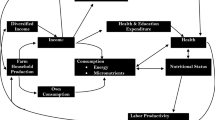Abstract
Globally, postharvest loss reduction has been emphasized as an effective option for improving food security and environmental sustainability. Yam production in the Zabzugu district of Northern Ghana suffers from high postharvest losses, with varying degrees of economic, social and environmental implications. Improving the welfare of farmers through postharvest loss reduction requires farmers’ effective management of the losses. The purpose of this study is to examine how effectively farmers manage postharvest losses and the rewards derived from such efforts. Using a cross-section of 201 randomly selected yam farmers from major production communities in the Zabzugu district of Northern Ghana, we applied a simultaneous equation modelling approach to examine the contemporaneous correlation between postharvest loss management and income. Results provided evidence that good postharvest loss management improves welfare of yam farmers through increased income earnings and vice versa, especially for those who produce for commercial purposes. On the other hand, subsistence farmers were better at managing postharvest losses, though with lower monetary rewards. The policy implications are that interventions should target farmer education and training to improve the skills of farmers in managing postharvest losses.
Similar content being viewed by others
References
Abass, A. B., Ndunguru, G., Mamiro, P., Alenkhe, B., Mlingi, N., & Bekunda, M. (2014). Post-harvest food losses in a maize-based farming system of semi-arid savannah area of Tanzania. Journal of Stored Products Research, 57, 49–57.
Aidoo, R., Danfoku, R. A., & Mensah, J. O. (2014). Determinants of postharvest losses in tomato production in the Offinso North district of Ghana. Journal of Development and Agricultural Economics, 6(8), 338–344.
Alliance for a Green Revolution in Africa (AGRA). (2013). Establishing the status of post-harvest losses and storage for major staple crops in eleven African countries (phase I). Nairobi: AGRA.
Awuah, R. T., & Akrasi, K. O. (2007). Suppression of tuber rot of yam caused by Aspergillus niger with a yam Rhizobacterium (Vol. 8, pp. 875–879). El-minia: African Crop Science Conference Proceedings.
Baloch, M. K., & Bibi, F. (2012). Effect of harvesting and storage conditions on the post-harvest quality and shelf life of mango (Mangifera indica L.) fruit. South African Journal of Botany, 83, 109–116.
Bourne, M. C. (2014). Food security: Postharvest losses. In N. K. V. Alfen (Ed.), Encyclopedia of Agriculture and food systems (pp. 338–351). Oxford: Academic Press.
Brown, P. R., McWilliam, A., & Khamphoukeo, K. (2013). Postharvest damage to stored grain by rodents in village environments in Laos. International Biodeterioration and Biodegradation, 82, 104–109.
Dhar, T., Chavas, J., & Gould, B. W. (2003). An empirical assessment of endogeneity issues in demand analysis for differentiated products. American Journal of Agricultural Economics, 85(3), 605–617.
Egyir, I. S., Sarpong, D. B., Obeng-Ofori, S. (2012). Final Report, M&E System for Postharvest Losses (Pilot Study), Policy Planning, Monitoring and Evaluation Directorate Ministry of Food and Agriculture, Ghana.
Fan, D., Kandasamy, S., Hodges, D. M., Critchley, A. T., & Prithiviraj, B. (2014). Pre-harvest treatment of spinach with Ascophyllum nodosum extract improves postharvest storage and quality. Scientia Horticulturae, 170, 70–74.
FAO. (2011). Global food losses and waste: extent, causes and prevention. Rome: UN FAO.
Gedikoglu, H., & McCann, L. M. (2012). Adoption of win-win, environment-oriented, and profit-oriented practices among livestock farmers. Journal of Soil and Water Conservation, 67(3), 218–227.
Greene, W. H. (2012). Econometric analysis (7th ed.). Upper Saddle River: Prentice Hall.
Gujarati, D. N. (2004). Basic econometrics (4th ed.). West Point Military Academy The The McGrawHill Companies.
Hounkonnou, D., Kossou, D., Kuyper, T. W., Leeuwis, C., Nederlof, E. S., Röling, N., Sakyi-Dawson, O., Traoré, M., and van Huis, A. (2012). An innovation systems approach to institutional change: Smallholder development in West Africa. Agricultural Systems 108, 74–83.
Hodges, R. J., Buzby, J. C., & Bennett, B. (2011). Postharvest losses and waste in developed and less developed countries: opportunities to improve resource use. The Journal of Agricultural Science, 149(S1), 37–45.
Hoque, M., Artz, G. M., Jarboe, D. H., & Martens, B. J. (2015). Producer participation in biomass markets: farm factors, market factors, and correlated choices. Journal of Agricultural and Applied Economics, 47(3), 317–344.
Jacoby, H. G. (2000). Access to markets and the benefits of rural roads. The Economic Journal, 110, 713–737.
Kiaya, V. (2014). Technical paper on postharvest losses; post-harvest losses and strategies to reduce them. Action Contre la Faim (ACF).
Koundouri, P., Nauges, C., & Tzouvelekas, V. (2006). Technology adoption under production uncertainty: theory and application to irrigation technology. American Journal of Agricultural Economics, 88, 657–670.
Kumar, M. V. S. (2009). The relationship between product and international diversification: the effects of short-run constraints and endogeneity. Strategic Management Journal, 30, 99–116.
Ministry of Food and Agriculture (2012). Pilot Program Based Budget for 2013–2015 (p. 6). Accra.
Nyadanu, D., Dapaah, H., & Agyekum, A. D. (2014). Resistance to postharvest microbial rot in yam: integration of genotype and storage methods. African Crop Science Journal, 22(2), 89–95.
Opara, L. U. (2003). YAMS: Postharvest Operation. Palmerston North: Massey University, Private Bag 11–222.
Tefera, T., Kanampiu, F., De Groote, H., Hellin, J., Mugo, S., Kimenju, S., & Banziger, M. (2011). The metal silo: an effective grain storage technology for reducing post-harvest insect and pathogen losses in maize while improving smallholder farmers’ food security in developing countries. Crop Protection, 30(3), 240–245.
Wooldridge, J. M (2012). Introductory econometrics: a modern approach, 5th edition. South-Western Cengage Learning.
World Bank (2011). Missing Food, The Case of Postharvest Grain Losses in Sub-Saharan Africa, Report No. 60371 – AFR, 1818 H Street, NW, Washington, DC 20433.
Author information
Authors and Affiliations
Corresponding author
Ethics declarations
Conflict of interest
The authors declare that they have no conflicts of interest.
Rights and permissions
About this article
Cite this article
Ansah, I.G.K., Tetteh, B.K.D. & Donkoh, S.A. Determinants and income effect of yam postharvest loss management: evidence from the Zabzugu District of Northern Ghana. Food Sec. 9, 611–620 (2017). https://doi.org/10.1007/s12571-017-0675-1
Received:
Accepted:
Published:
Issue Date:
DOI: https://doi.org/10.1007/s12571-017-0675-1




